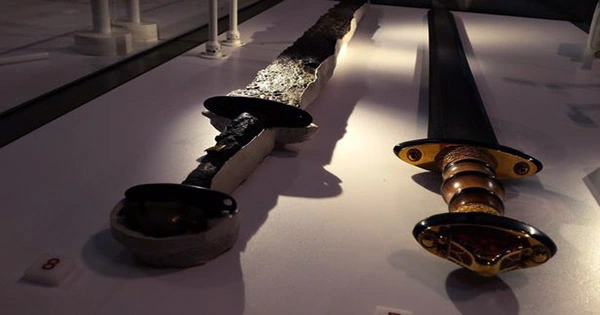An amateur treasure hunter in Norway discovered a little but significant discovery last year. He had found a little bit of metal with no clear utility on a farm on Norway’s western coast, so it was half a finding. The rest of the jigsaw was finally revealed this spring. Another archeological find was made by another amateur enthusiast (who happened to be a buddy of the first). This one was more obvious: it was a huge, elegant, and intricate sword.
The most startling aspect of the two relics had still to be revealed: they were, in fact, portions of the same find. Local archeologists are hailing the sword as a particularly uncommon and exquisite example of Viking craftsmanship now that it has been reassembled after nearly 1,200 years. In a statement, Ann Zanette Glrstad, an archaeologist at the University of Oslo in Norway, said, “The sword is probably what we call a D-sword.” In other words, it’s “one of the finest embellished, heaviest sword kinds from the Viking Age,” she noted.
Only the hilt has been found, but it’s enough to get a sense of how much labor went into the sword’s manufacture. “The décor comprises aspects of the traditional animal design from the Late Iron Age, as well as geometric shapes of silver with the so-called niello method – that is, a metal combination was put as black stripes in the silver,” Glrstad stated. “The bottom helmet is ornamented in the same manner as the grip, and the helmet is formed like an animal head on each end,” she explained.
The sword is one of roughly 20 comparable items discovered in Norway, but many of them were likely imported, according to Glrstad. While you may think that a Viking sword unearthed in one of the Vikings’ old homelands would have been produced close to where it was discovered, Glrstad stated that the design on the blade could suggest that it was originally made in the Frankish Empire or England.
Similar swords have been recovered around Europe, with the closest specimen finding in a ninth-century grave on the Scottish island of Eigg. That means the find “will be of considerable interest to specialists from other regions of Europe,” according to Glrstad, who added that after the sword has been properly conserved, the University “will then contact researchers overseas to provide greater clarity to the sword’s origins and parallels.”
For the time being, most of the sword’s provenance is unknown – though there are a few hints. A large, highly ornamented sword from a distant place would have been difficult to come by without a lot of social rank, therefore the owner was obviously someone prominent. The blade was also unearthed beside the burial of a wealthy Viking woman known as the “Gausel Queen,” who was buried with valuables from as far away as Ireland. “We knew this location was important, but seeing something like this was beyond unexpected!” According to Hkon Reiersen, acting head of the collection section of the Norwegian Archeological Museum.
The sword is now being restored at the museum and will be shown there once it is finished; sword fans may follow the preservation process on the institution’s website and social media pages. “Without a doubt, this is an absolutely unique finding,” Glrstad added. “Now we’re really looking forward to seeing the sword in its entirety.”















